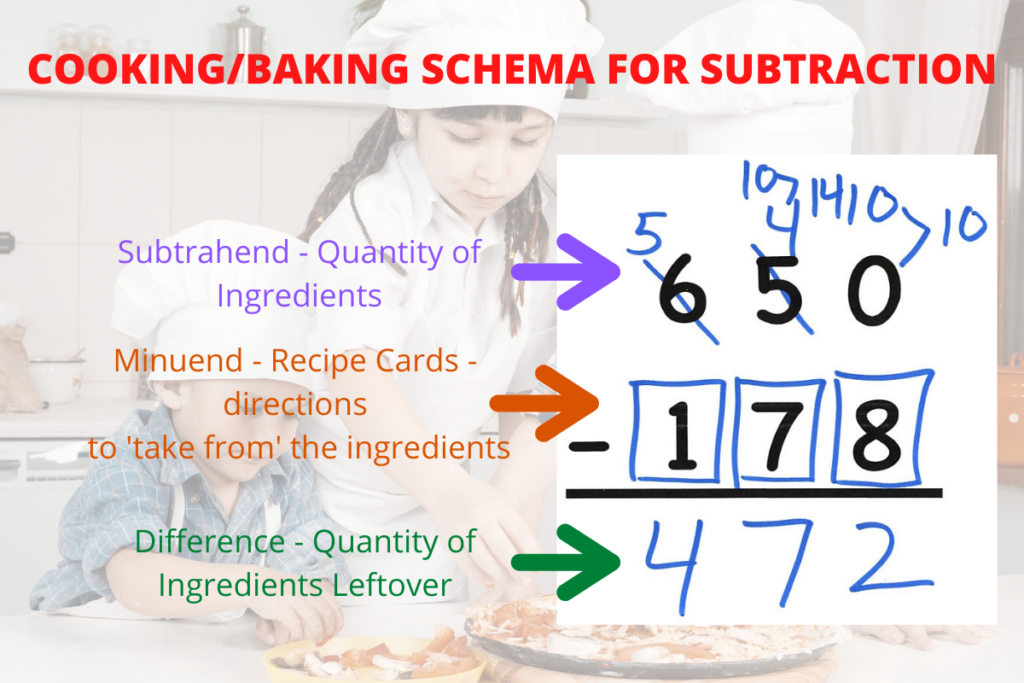‘Schema’ as described in this article refers to the prior knowledge and life experience a student brings to a novel task which will assist her or him in making connections to the task to build new understanding. Often in math related articles, ‘schema’ refers to ‘schematic’ diagrams or models, for number stories, but in this article ‘schema’ is used as it is in Language Arts – prior knowledge/experience.
In the upper elementary grades, subtraction computations within number stories and in isolation, are quite abstract. Two and 3-digit subtraction computations, especially in isolation are extremely abstract. If students are using the most common and efficient method of subtraction, the standard algorithm, with no connected schema, there are many opportunities for them to make errors.
It is for this reason that it is so important to tie some prior knowledge/experience to the concept of subtraction and the abstract process of the algorithm. The schema that works well with subtraction and the algorithm for subtraction is the schema of cooking/baking. Most students have some experience with cooking/baking. They have followed a recipe and taken ingredients from a quantity of ingredients to make their item or dish. When finished, their ingredient quantities were less than what they started with. It sounds a lot like subtraction, doesn’t it?
With the cooking/baking schema for subtraction, the minuend, subtrahend, and difference are clearly defined. The minuend is the recipes – directions to remove some quantity of ingredients, not an actual quantity or value – this is critical for students to conceptualize and internalize. The subtrahend is the quantity of ingredients before the cooking/baking process begins. The difference is the quantity of ingredients that remains after the cooking/baking process is completed.
Schema in Action

The Good Neighbors’ Cheese Feast establishes the cooking/baking schema for subtraction and the subtraction algorithm.
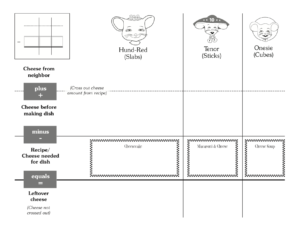
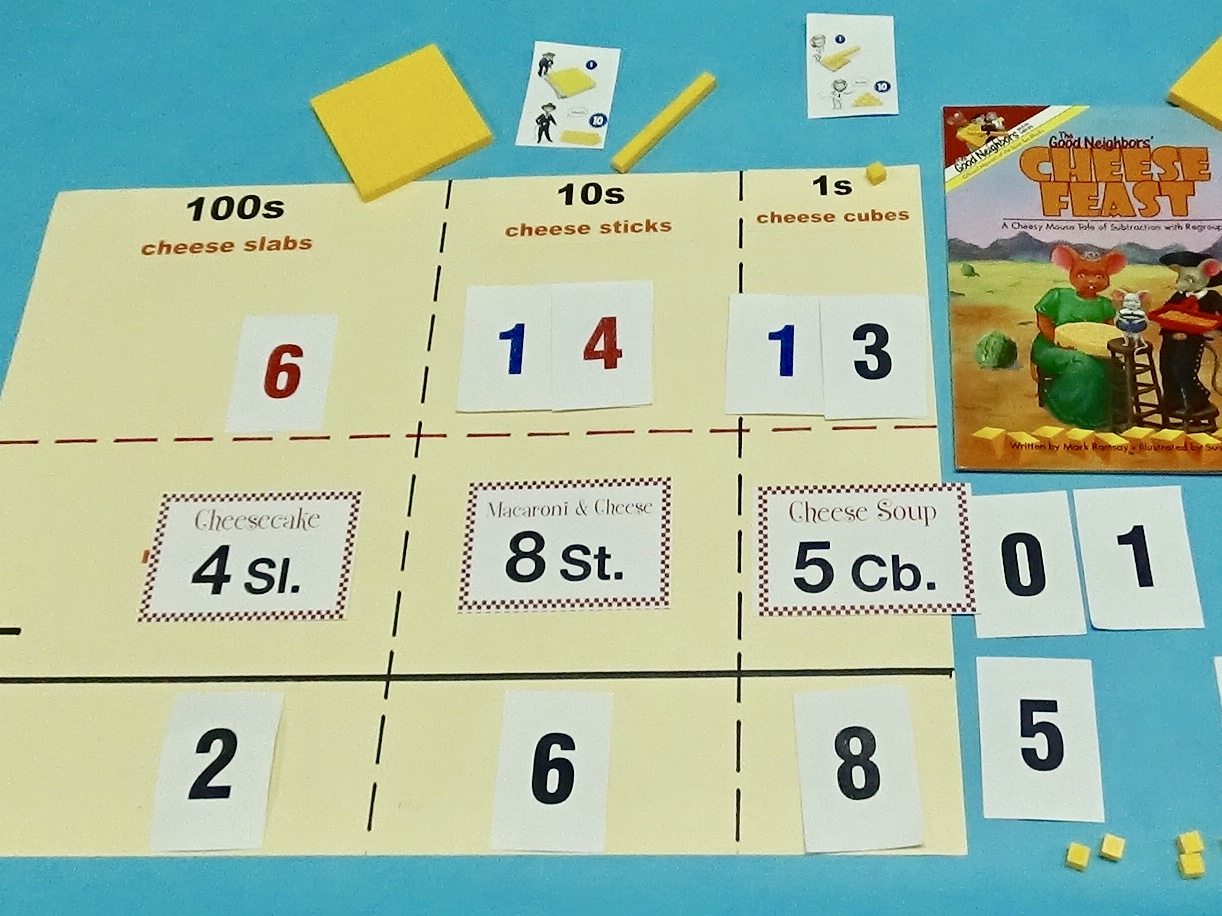
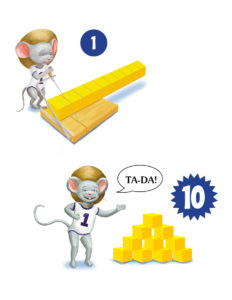

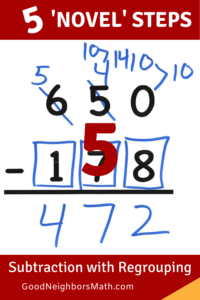
Luckily for the math community, there is a math picture book that uses the schema of cooking/baking for subtraction – The Good Neighbors’ Cheese Feast, so it is a great way to introduce the schema to students. In the story, three mice, of varied size with varied size cheese blocks, must work together to insure each has enough cheese to make his or her cheesy dish. The story’s narrative mirrors the steps of the standard algorithm as demonstrated with base ten blocks.
The “5 ‘Novel’ Steps to Teach Subtraction with Regrouping – Conceptually” incorporates the cooking/baking schema throughout, which make the steps so powerful and lasting. The Good Neighbors Subtraction Template, first used by teachers to model the subtraction process, and then by students to solve subtraction computations pictorially, clearly distinguishes the minuend as the recipe cards, not an actual value. There are no meaningless ‘gimmicky’ tricks needed to tell the difference between the minuend and the subtrahend because every student knows that recipe cards are not a quantity but a set of directions. Students using their schema, look at the minuend (recipe card) and then the subtrahend (quantity available), and determine if they have enough quantity to subtract (complete the recipe). If they do not, they realize they must regroup from the next place value to get a greater quantity in order to subtract.
There are no meaningless ‘gimmicky’ tricks needed to tell the difference between the minuend and the subtrahend because every student knows that recipe cards are not a quantity but a set of directions.
The icon for the regrouping process in the cooking/baking schema for subtraction is the cheese slicer. The cheese slicer is the tool the characters in The Good Neighbors’ Cheese Feast use to slice the bigger block of cheese into their 10 smaller sized blocks.
Even in Step 5 of the “5 ‘Novel’ Steps to Teach Subtraction with Regrouping – Conceptually” where students eventually solve computations numerically with no template, the cooking/baking schema continues to be emphasized. Students are instructed to draw a simple rectangular border around each digit in the minuend to maintain the schema, and remind the students that the minuend is like a recipe card that has no value. Drawing the borders around the minuend digits is a simple task, but it helps maintain the schema for students.
Establishing a conceptual schema for subtraction benefits all students, but particularly students who struggle in math and students with learning disabilities. It is especially important to help these students make connections to abstract concepts/skills such as subtraction and the subtraction algorithm so they can retain the concepts/skills for the long-term. So give up the gimmicks and tricks and teach the cooking/baking schema for subtraction and have lasting results.
